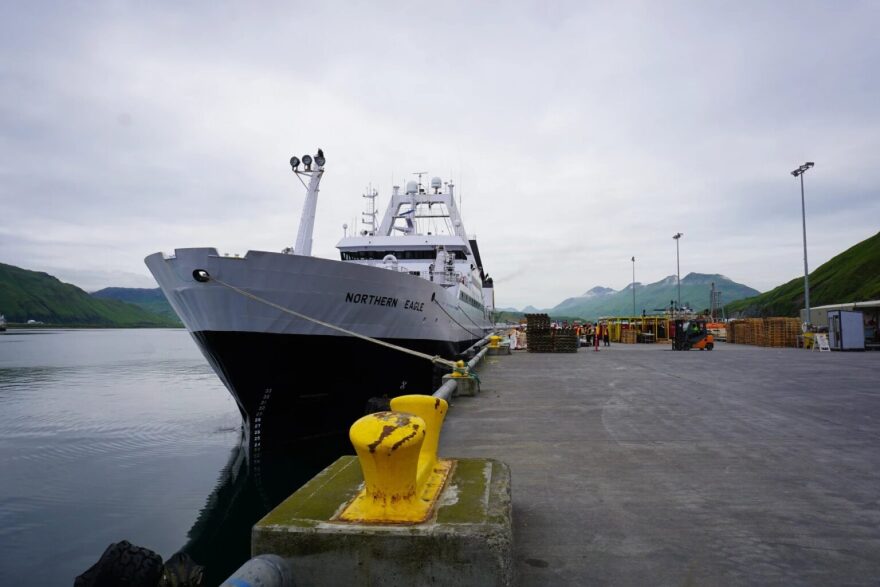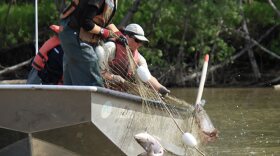At its October meeting in Anchorage, the North Pacific Fishery Management Council took a small step toward a possible cap on chum salmon bycatch, passing a motion to consider a handful of alternative management schemes. There is already a so-called “hard cap” on chinook salmon bycatch, which requires the trawl fleet to be shut down if too many chinook salmon are caught incidentally.
One alternative for chum recommends caps ranging from 200,000 to 550,000 total fish, while another would only put a cap on those chum determined to be of Western Alaska origin. Yet another would have caps set based on run strength indicators from the Yukon and Kuskokwim rivers and Norton Sound. Finally, a fourth alternative would allow the pollock industry to avoid a hard cap on chum bycatch entirely, through an incentive-based system.
In public testimony as the council met, Tanana Chiefs Conference Chief Chairman Brian Ridley pushed back against the idea of self-managed bycatch.
"I want to emphasize that voluntary incentive programs self-managed by industry do not create accountability or fulfill the federal trust obligations to tribes," Ridley said. "Trusting that commercial fishermen will do the right thing is not a solution on the table."
On the other side of the debate, Brent Paine, executive director of Seattle-based trawler trade association United Catcher Boats, testified in support of incentive-based management.
"We can incentivize individual captains to minimize behavior. We can reward captains that do a good job, and we can penalize captains that do a bad job," Paine said. "On a hard cap, you can't do that."
The next step in the council process is creating a federal environmental impact statement (EIS) for these alternatives. The deadline for the EIS is July 11, 2025.
By December 2024, the council said that it will make its final decision on which alternative or combination of alternatives to pursue.
Critics say that the council has repeatedly failed to take any real action on chum, and that its most recent meeting was no exception. Tim Bristol, executive director of conservation group SalmonState, said that economic concerns have skewed the argument.
"As long as we are stuck in a situation where doing anything to reduce bycatch in a significant way has to be balanced against the profits of those trawlers, I think it's going to be directed fisheries and Yukon-Kuskokwim communities that end up losing," Bristol said.
Frank Kelty, a fisheries consultant for the city of Unalaska, pointed out in his council testimony that some communities rely on those profits.
"We’re very concerned that if we had a hard cap that was very restrictive, and we had a spike in Asian and Russian chums, it would shut down the pollock fishery, which would be devastating to Unalaska," Kelty said.
There are numerous factors muddying the waters when it comes to action that could ultimately cut into pollock trawler profit margins. One is the need to agree on how many of the chum caught at sea are actually bound for Western Alaska rivers.
The council’s preliminary analysis cites genetic analysis data going back to 2011 indicating an annual average of around 50,000 Western Alaska chum caught by the pollock fishery. This represents roughly 18% of total chum bycatch. But that same analysis notes significant variability in these numbers.
Another hotly debated factor is climate change, given that warmer ocean temperatures and a subsequent loss of prey have been linked to chum declines across the North Pacific.
To complicate matters further, data indicate that roughly 68% of chum caught by the pollock fishery are not from Alaska waters but from Asian sources, mostly hatcheries. The combination of these factors, increased competition for a dwindling food supply, could be a double whammy for Western Alaska chum.
Association of Village Council Presidents Chief Executive Officer Vivian Korthuis testified that environmental factors should not distract from the need for quick action on bycatch.
"What is happening in our villages, in our rivers is inequitable, it's unfair," Korthuis said. "Climate change cannot be used as an excuse not to address the problem we are facing."
With years to go until federal regulatory changes could take effect and the potential benefits of drastic changes in management could be examined, the calls to protect Western Alaska chum salmon will likely continue to grow louder.
The council’s next meeting will be held from Dec. 4 to Dec. 12 at the Hilton Hotel in Anchorage.




